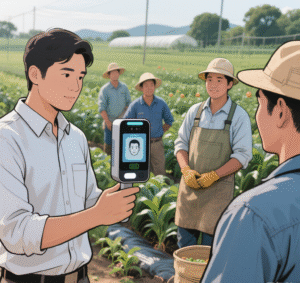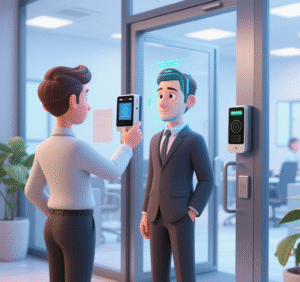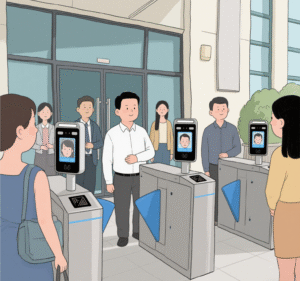What Is A Face Recognition System?
A Face Recognition System is an AI-powered biometric solution designed to identify or verify a person by analyzing facial patterns. It captures an image or video, processes the data, and matches it against stored facial information. With deep learning algorithms and high-resolution imaging, modern Face Recognition Systems offer unmatched accuracy and speed.
How It Works
A Face Recognition System works through several key steps:
Image Capture
The system uses a camera to capture a person’s face, either in a photo or video stream.Facial Feature Extraction
AI algorithms analyze unique facial features — such as the distance between the eyes, nose shape, and jawline — and convert them into a mathematical template.Matching and Verification
The generated template is compared to stored data in the database. If a match is found, access is granted or the identity is confirmed.Liveness Detection (Optional but Recommended)
Advanced Face Recognition Systems include liveness detection to ensure that the image is from a real, live person, preventing spoofing with photos or videos.
Key Features of an Advanced Face Recognition System
High Accuracy and Speed
Modern Face Recognition Systems can recognize individuals within seconds, even in crowded or low-light environments. This makes them ideal for high-traffic areas like shopping malls, stadiums, and transport hubs.
Contactless and Hygienic Verification
Unlike fingerprint scanners or ID cards, a Face Recognition System offers completely contactless verification, reducing the risk of cross-contamination — an essential feature in the post-pandemic era.
Multi-Mode Integration
Many Face Recognition Systems can be integrated with access control devices, attendance management software, and visitor registration systems, providing an all-in-one security solution.
Liveness Detection
To prevent fraud, advanced systems use liveness detection to differentiate between a real person and a photograph or video.
Applications of Face Recognition System




Access Control – Enhance security in offices, factories, and government buildings.
Time Attendance – Integrate with employee attendance software for automated logging.
Border Control – Improve immigration checks at airports and seaports.
Retail & Hospitality – Personalize customer experiences and strengthen store security.
Public Safety – Support law enforcement in identifying persons of interest.
Why Businesses are Adopting Face Recognition Systems
The growing adoption of Face Recognition Systems is driven by three major factors: enhanced security, operational efficiency, and user convenience. Compared to traditional methods, facial recognition eliminates the need for passwords, ID cards, or manual checks, saving time and reducing human error. Additionally, AI-powered analytics can provide valuable insights into visitor patterns and workforce management.
Future Trends in Face Recognition Technology
With the integration of artificial intelligence (AI), cloud storage, and 5G connectivity, Face Recognition Systems will become even faster and more secure. Future developments are expected to include improved 3D recognition, wider deployment in smart cities, and stronger privacy protection measures.
Conclusion
A Face Recognition System is no longer just a futuristic concept — it is a practical, efficient, and secure solution already reshaping industries worldwide. Whether you are managing access control, time attendance, or public safety, adopting a modern Face Recognition System can provide the perfect balance of security, convenience, and innovation.
FAQ
Yes. Modern Face Recognition Systems use encryption and secure databases to store and process facial data, making them safe for both businesses and individuals.
Many advanced systems are equipped with infrared (IR) cameras, allowing accurate recognition even in low-light or nighttime environments.
Liveness detection ensures that the face being scanned belongs to a live person, preventing spoofing attacks using photos, masks, or videos.
It depends on the system’s algorithm. Some modern solutions are mask-friendly and can recognize individuals based on visible facial features.
It can be applied in offices, factories, airports, hotels, banks, schools, and public safety projects for secure and efficient access control.
Contact Us
We would love to speak with you.
Feel free to reach out using the below details.

